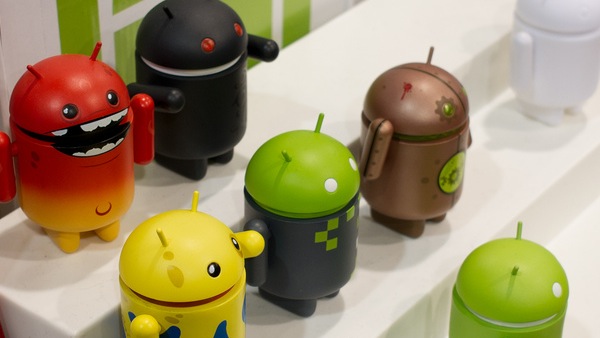
A new version of Android will be available in November, initally on the Samsung Galaxy Nexus smartphone. Much of the analysis of this Ice Cream Sandwich version of Android is focused on the implications of it running on both smartphones and tablets, where older versions of Android ran on one or the other (1), as well as shiny new gimmicks such as face recognition to unlock a handset.
This unification of smartphones and tablets is a red herring. Other things matter much more for Android. Android tablets are failing in the market, while Google’s smartphones sell in enormous numbers. This is a major issue for Google.
In tablets, Google’s own numbers show the extent to which Android is struggling. There are approximately 3.4m Android tablets running the official version of Android intended for tablets (2). This is small compared with the tablet market leader from Apple. Over 39.9m iPads were shipped up to the end of September this year. In the third quarter of 2011 alone, Apple shipped over 11m iPads, almost three times that of all official Android tablets to date.
Android smartphones are a massive success. Given the above Android tablet figures, the vast majority of the 550,000 Android devices activated each day must be smartphones. Google has already caught Apple in smartphone adoption. There are 190m Android devices in use compared with 250m Apple iOS devices. But in smartphones the adoption numbers show that Android is already ahead: Apple has shipped a total of 146m iPhones to date (end September 2011) --some of those units are over three years old and will no longer be in use -- while there are approximately 180m Android smartphones (3).
Google is succeeding with smartphones, but not tablets, as a solid media strategy isn’t essential for success in the smartphone market.
Why?
Smartphones remain a highly communication-centric device. Google’s Android delivers a great phone, messaging and social network experience with a broad app store for utilities that matches and in some areas betters the iPhone. Android communication apps are able to integrate closely with the built-in apps unlike the iPhone’s design (4). Plus, Android smartphones are much more affordable than the iPhone. Android smartphones are sold at a very wide range of prices which increases their potential market. For example, on pre-pay in the UK Android smartphones start as low as £49.95 (no contract commitment). At a slightly higher price of around £100 there are multiple models available.
Google’s media strategy has been a bit of a mess compared with its competitors. Google has taken different assumptions to the media strategies of Apple, Microsoft, Sony, and of the media industry itself.
In short, with media and content-based products Google:
- Fundamentally believes in the power of computer code to deliver content services. For Google, the problem is all of the successful media services rely on human curation. Google’s code has not yet matched the nuances of human editors. It likely will do so in the future, but hasn’t yet. Google News is a great example of Google’s way of thinking: by default Google uses algorithms to create content services. Google News successfully shows the most popular stories from many publishers, but due to its use of a popularity ranking, it routinely fails to spot exclusive scoops that news publishers use as their very top stories and will be highly read. Now, link sharing on Google+ is intended to help improve Google’s understanding of what matters to people.
- Has operated a centralized global media strategy. Media strategy needs to be tailored to country-based rights availability. This takes time and humans to drive content deals, not computers that can’t lunch or do coffee. It takes longer. Strangely, Google has long understood that media sales teams need to be regional to drive advertising revenues, but is only slowly realizing that it needs the same approach for media content. This has hindered Google’s TV initiatives where securing TV content is critical, and has delayed Google TV’s launch outside of the US. The evolution of YouTube with its increasing inclusion of traditional media content shows that Google is changing now.
- Has often acted first, asked permission later. Google’s decision to digitize the world’s books antagonized publishers. More recently, Google’s music locker service -- in the admittedly beta Google Music -- encourages individuals to upload their music to Google’s servers but was undertaken with minimal discussion with the music industry. Steven Levy’s book, In the Plex, recounts a similar story about YouTube’s early years (Or see this reaction from Belgium publishers)
Tablets are strongly media consumption devices. Amazon gets this by building what I described as the first true media tablet. Apple has strengths here due to its iPod heritage and existing ties to the music, movie, TV and publishing industries for iTunes and iBooks.
If Google is to succeed in tablets, what the new Ice Cream Sandwich version of Android needs above all else is to re-kindle Google’s media strategy. And yes, I did mean to use the word "kindle" there. Amazon has led the way. Google needs to improve.
I’ve written in the past that what makes devices smart is their software soul, and not the shallow exterior of hardware design, however great it may be. Steve Jobs used the same phrasing more recently (although I doubt he read my report first).
There’s another phrase of Jobs which is even more relevant to what Google needs to do in tablets. At the time he said it, most thought Jobs was needling Microsoft, the old enemy. I disagree. I think this was aimed at Google’s belief in the power of computer code above human curation:
It’s in Apple’s DNA that technology alone is not enough—it’s technology married with liberal arts, married with the humanities, that yields us the result that makes our heart sing, and nowhere is that more true than in these post-PC devices.
Google’s obsession with algorithms and code runs counter to a liberal arts relationship. Google needs a better media strategy. Google needs to evolve to find a media software soul to place at the heart its Android tablets.
Of course, for those building Android tablets and Android smartphones -- HTC, Samsung, Sony and the rest -- Google’s media strategy omissions provides room to differentiate at the cost of some significant spending to create a media product offering.
(1) Previously, the v3.x Honeycomb version of Android was only available for tablets, and all smartphones ran the older Froyo or Gingerbread Android software.
(2) This is based on the data Google publishes on the proportion of Android devices using each version of Android OS and the reported data on the total number of Android devices in use. As v3.x Honeycomb is only shipped on tablets, this enables an estimation of the number of Honeycomb Android tablets to be made across all of the different device makers that ship Honeycomb tablets: Motorola, Sony, HTC, Samsung, etc. Data on Android OS versions in use is published here: http://developer.android.com/resources/dashboard/platform-versions.html . Since I wrote this piece, Android head Andy Rubin has stated there are about 6m Android tablets in total in the wild. The difference represents those tablets that run Android v2.3 Gingerbread or v2.2 Froyo rather than the tablet-optimized v3 Honeycomb.
(3) Reasons: There are a small number of Android devices that are portable media players, for example from Samsung and Philips among others, plus there are also a few tablets shipped with the smartphone version of Android, such as the original Samsung Galaxy Tab and the HTC Flyer…. It’s not possible derive an exact number of Android smartphones in use from these publicly stated figures from Google.
(4) Voice over IP (VoIP) apps such as Skype run more consistently with Android multitasking than they do on the iPhone where iOS routinely decides they are no longer needed, and shuts down such background apps without asking the user.
 Ian Fogg is a mobile industry analyst, consultant and product manager. He is a former principal at Forrester; research director at Jupiter Research; and marketing and/or product management at Psion, 3/Hutchison and Cable & Wireless Communications.
Ian Fogg is a mobile industry analyst, consultant and product manager. He is a former principal at Forrester; research director at Jupiter Research; and marketing and/or product management at Psion, 3/Hutchison and Cable & Wireless Communications.

